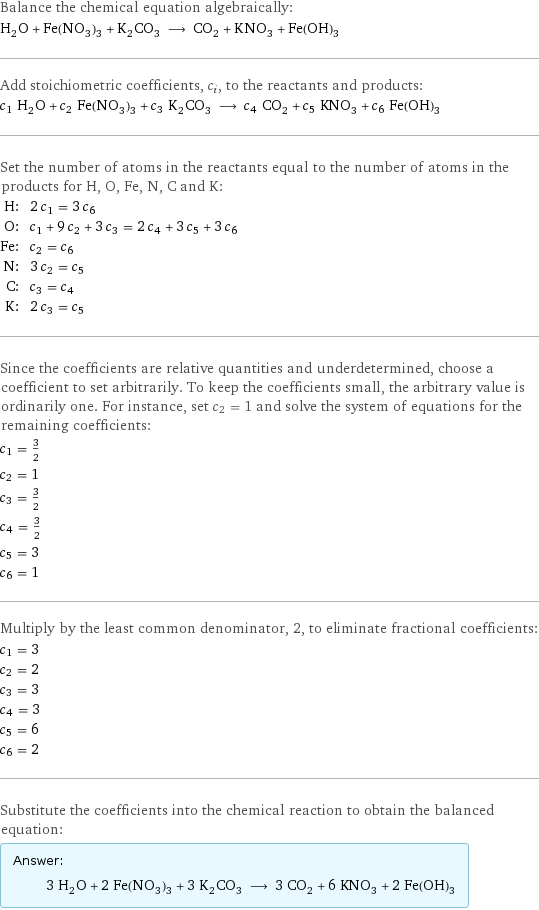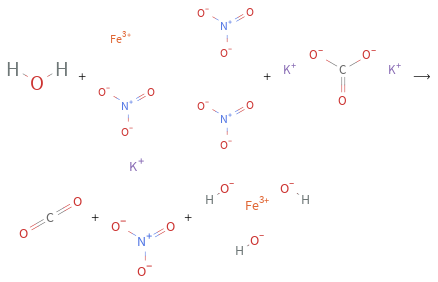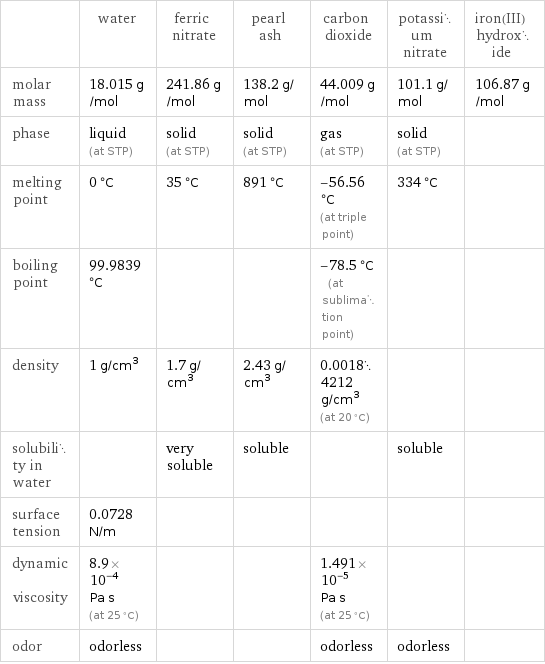Input interpretation

H_2O water + Fe(NO_3)_3 ferric nitrate + K_2CO_3 pearl ash ⟶ CO_2 carbon dioxide + KNO_3 potassium nitrate + Fe(OH)_3 iron(III) hydroxide
Balanced equation

Balance the chemical equation algebraically: H_2O + Fe(NO_3)_3 + K_2CO_3 ⟶ CO_2 + KNO_3 + Fe(OH)_3 Add stoichiometric coefficients, c_i, to the reactants and products: c_1 H_2O + c_2 Fe(NO_3)_3 + c_3 K_2CO_3 ⟶ c_4 CO_2 + c_5 KNO_3 + c_6 Fe(OH)_3 Set the number of atoms in the reactants equal to the number of atoms in the products for H, O, Fe, N, C and K: H: | 2 c_1 = 3 c_6 O: | c_1 + 9 c_2 + 3 c_3 = 2 c_4 + 3 c_5 + 3 c_6 Fe: | c_2 = c_6 N: | 3 c_2 = c_5 C: | c_3 = c_4 K: | 2 c_3 = c_5 Since the coefficients are relative quantities and underdetermined, choose a coefficient to set arbitrarily. To keep the coefficients small, the arbitrary value is ordinarily one. For instance, set c_2 = 1 and solve the system of equations for the remaining coefficients: c_1 = 3/2 c_2 = 1 c_3 = 3/2 c_4 = 3/2 c_5 = 3 c_6 = 1 Multiply by the least common denominator, 2, to eliminate fractional coefficients: c_1 = 3 c_2 = 2 c_3 = 3 c_4 = 3 c_5 = 6 c_6 = 2 Substitute the coefficients into the chemical reaction to obtain the balanced equation: Answer: | | 3 H_2O + 2 Fe(NO_3)_3 + 3 K_2CO_3 ⟶ 3 CO_2 + 6 KNO_3 + 2 Fe(OH)_3
Structures

+ + ⟶ + +
Names

water + ferric nitrate + pearl ash ⟶ carbon dioxide + potassium nitrate + iron(III) hydroxide
Equilibrium constant
![Construct the equilibrium constant, K, expression for: H_2O + Fe(NO_3)_3 + K_2CO_3 ⟶ CO_2 + KNO_3 + Fe(OH)_3 Plan: • Balance the chemical equation. • Determine the stoichiometric numbers. • Assemble the activity expression for each chemical species. • Use the activity expressions to build the equilibrium constant expression. Write the balanced chemical equation: 3 H_2O + 2 Fe(NO_3)_3 + 3 K_2CO_3 ⟶ 3 CO_2 + 6 KNO_3 + 2 Fe(OH)_3 Assign stoichiometric numbers, ν_i, using the stoichiometric coefficients, c_i, from the balanced chemical equation in the following manner: ν_i = -c_i for reactants and ν_i = c_i for products: chemical species | c_i | ν_i H_2O | 3 | -3 Fe(NO_3)_3 | 2 | -2 K_2CO_3 | 3 | -3 CO_2 | 3 | 3 KNO_3 | 6 | 6 Fe(OH)_3 | 2 | 2 Assemble the activity expressions accounting for the state of matter and ν_i: chemical species | c_i | ν_i | activity expression H_2O | 3 | -3 | ([H2O])^(-3) Fe(NO_3)_3 | 2 | -2 | ([Fe(NO3)3])^(-2) K_2CO_3 | 3 | -3 | ([K2CO3])^(-3) CO_2 | 3 | 3 | ([CO2])^3 KNO_3 | 6 | 6 | ([KNO3])^6 Fe(OH)_3 | 2 | 2 | ([Fe(OH)3])^2 The equilibrium constant symbol in the concentration basis is: K_c Mulitply the activity expressions to arrive at the K_c expression: Answer: | | K_c = ([H2O])^(-3) ([Fe(NO3)3])^(-2) ([K2CO3])^(-3) ([CO2])^3 ([KNO3])^6 ([Fe(OH)3])^2 = (([CO2])^3 ([KNO3])^6 ([Fe(OH)3])^2)/(([H2O])^3 ([Fe(NO3)3])^2 ([K2CO3])^3)](../image_source/1eb06ec6ad83ddf7ffa87d164ee312f3.png)
Construct the equilibrium constant, K, expression for: H_2O + Fe(NO_3)_3 + K_2CO_3 ⟶ CO_2 + KNO_3 + Fe(OH)_3 Plan: • Balance the chemical equation. • Determine the stoichiometric numbers. • Assemble the activity expression for each chemical species. • Use the activity expressions to build the equilibrium constant expression. Write the balanced chemical equation: 3 H_2O + 2 Fe(NO_3)_3 + 3 K_2CO_3 ⟶ 3 CO_2 + 6 KNO_3 + 2 Fe(OH)_3 Assign stoichiometric numbers, ν_i, using the stoichiometric coefficients, c_i, from the balanced chemical equation in the following manner: ν_i = -c_i for reactants and ν_i = c_i for products: chemical species | c_i | ν_i H_2O | 3 | -3 Fe(NO_3)_3 | 2 | -2 K_2CO_3 | 3 | -3 CO_2 | 3 | 3 KNO_3 | 6 | 6 Fe(OH)_3 | 2 | 2 Assemble the activity expressions accounting for the state of matter and ν_i: chemical species | c_i | ν_i | activity expression H_2O | 3 | -3 | ([H2O])^(-3) Fe(NO_3)_3 | 2 | -2 | ([Fe(NO3)3])^(-2) K_2CO_3 | 3 | -3 | ([K2CO3])^(-3) CO_2 | 3 | 3 | ([CO2])^3 KNO_3 | 6 | 6 | ([KNO3])^6 Fe(OH)_3 | 2 | 2 | ([Fe(OH)3])^2 The equilibrium constant symbol in the concentration basis is: K_c Mulitply the activity expressions to arrive at the K_c expression: Answer: | | K_c = ([H2O])^(-3) ([Fe(NO3)3])^(-2) ([K2CO3])^(-3) ([CO2])^3 ([KNO3])^6 ([Fe(OH)3])^2 = (([CO2])^3 ([KNO3])^6 ([Fe(OH)3])^2)/(([H2O])^3 ([Fe(NO3)3])^2 ([K2CO3])^3)
Rate of reaction
![Construct the rate of reaction expression for: H_2O + Fe(NO_3)_3 + K_2CO_3 ⟶ CO_2 + KNO_3 + Fe(OH)_3 Plan: • Balance the chemical equation. • Determine the stoichiometric numbers. • Assemble the rate term for each chemical species. • Write the rate of reaction expression. Write the balanced chemical equation: 3 H_2O + 2 Fe(NO_3)_3 + 3 K_2CO_3 ⟶ 3 CO_2 + 6 KNO_3 + 2 Fe(OH)_3 Assign stoichiometric numbers, ν_i, using the stoichiometric coefficients, c_i, from the balanced chemical equation in the following manner: ν_i = -c_i for reactants and ν_i = c_i for products: chemical species | c_i | ν_i H_2O | 3 | -3 Fe(NO_3)_3 | 2 | -2 K_2CO_3 | 3 | -3 CO_2 | 3 | 3 KNO_3 | 6 | 6 Fe(OH)_3 | 2 | 2 The rate term for each chemical species, B_i, is 1/ν_i(Δ[B_i])/(Δt) where [B_i] is the amount concentration and t is time: chemical species | c_i | ν_i | rate term H_2O | 3 | -3 | -1/3 (Δ[H2O])/(Δt) Fe(NO_3)_3 | 2 | -2 | -1/2 (Δ[Fe(NO3)3])/(Δt) K_2CO_3 | 3 | -3 | -1/3 (Δ[K2CO3])/(Δt) CO_2 | 3 | 3 | 1/3 (Δ[CO2])/(Δt) KNO_3 | 6 | 6 | 1/6 (Δ[KNO3])/(Δt) Fe(OH)_3 | 2 | 2 | 1/2 (Δ[Fe(OH)3])/(Δt) (for infinitesimal rate of change, replace Δ with d) Set the rate terms equal to each other to arrive at the rate expression: Answer: | | rate = -1/3 (Δ[H2O])/(Δt) = -1/2 (Δ[Fe(NO3)3])/(Δt) = -1/3 (Δ[K2CO3])/(Δt) = 1/3 (Δ[CO2])/(Δt) = 1/6 (Δ[KNO3])/(Δt) = 1/2 (Δ[Fe(OH)3])/(Δt) (assuming constant volume and no accumulation of intermediates or side products)](../image_source/b0d08ee757aa689b92a8f6407a0f3317.png)
Construct the rate of reaction expression for: H_2O + Fe(NO_3)_3 + K_2CO_3 ⟶ CO_2 + KNO_3 + Fe(OH)_3 Plan: • Balance the chemical equation. • Determine the stoichiometric numbers. • Assemble the rate term for each chemical species. • Write the rate of reaction expression. Write the balanced chemical equation: 3 H_2O + 2 Fe(NO_3)_3 + 3 K_2CO_3 ⟶ 3 CO_2 + 6 KNO_3 + 2 Fe(OH)_3 Assign stoichiometric numbers, ν_i, using the stoichiometric coefficients, c_i, from the balanced chemical equation in the following manner: ν_i = -c_i for reactants and ν_i = c_i for products: chemical species | c_i | ν_i H_2O | 3 | -3 Fe(NO_3)_3 | 2 | -2 K_2CO_3 | 3 | -3 CO_2 | 3 | 3 KNO_3 | 6 | 6 Fe(OH)_3 | 2 | 2 The rate term for each chemical species, B_i, is 1/ν_i(Δ[B_i])/(Δt) where [B_i] is the amount concentration and t is time: chemical species | c_i | ν_i | rate term H_2O | 3 | -3 | -1/3 (Δ[H2O])/(Δt) Fe(NO_3)_3 | 2 | -2 | -1/2 (Δ[Fe(NO3)3])/(Δt) K_2CO_3 | 3 | -3 | -1/3 (Δ[K2CO3])/(Δt) CO_2 | 3 | 3 | 1/3 (Δ[CO2])/(Δt) KNO_3 | 6 | 6 | 1/6 (Δ[KNO3])/(Δt) Fe(OH)_3 | 2 | 2 | 1/2 (Δ[Fe(OH)3])/(Δt) (for infinitesimal rate of change, replace Δ with d) Set the rate terms equal to each other to arrive at the rate expression: Answer: | | rate = -1/3 (Δ[H2O])/(Δt) = -1/2 (Δ[Fe(NO3)3])/(Δt) = -1/3 (Δ[K2CO3])/(Δt) = 1/3 (Δ[CO2])/(Δt) = 1/6 (Δ[KNO3])/(Δt) = 1/2 (Δ[Fe(OH)3])/(Δt) (assuming constant volume and no accumulation of intermediates or side products)
Chemical names and formulas

| water | ferric nitrate | pearl ash | carbon dioxide | potassium nitrate | iron(III) hydroxide formula | H_2O | Fe(NO_3)_3 | K_2CO_3 | CO_2 | KNO_3 | Fe(OH)_3 Hill formula | H_2O | FeN_3O_9 | CK_2O_3 | CO_2 | KNO_3 | FeH_3O_3 name | water | ferric nitrate | pearl ash | carbon dioxide | potassium nitrate | iron(III) hydroxide IUPAC name | water | iron(+3) cation trinitrate | dipotassium carbonate | carbon dioxide | potassium nitrate | ferric trihydroxide
Substance properties

| water | ferric nitrate | pearl ash | carbon dioxide | potassium nitrate | iron(III) hydroxide molar mass | 18.015 g/mol | 241.86 g/mol | 138.2 g/mol | 44.009 g/mol | 101.1 g/mol | 106.87 g/mol phase | liquid (at STP) | solid (at STP) | solid (at STP) | gas (at STP) | solid (at STP) | melting point | 0 °C | 35 °C | 891 °C | -56.56 °C (at triple point) | 334 °C | boiling point | 99.9839 °C | | | -78.5 °C (at sublimation point) | | density | 1 g/cm^3 | 1.7 g/cm^3 | 2.43 g/cm^3 | 0.00184212 g/cm^3 (at 20 °C) | | solubility in water | | very soluble | soluble | | soluble | surface tension | 0.0728 N/m | | | | | dynamic viscosity | 8.9×10^-4 Pa s (at 25 °C) | | | 1.491×10^-5 Pa s (at 25 °C) | | odor | odorless | | | odorless | odorless |
Units
